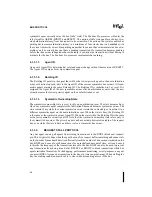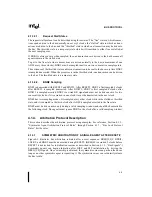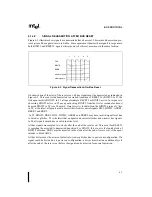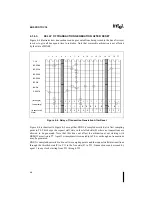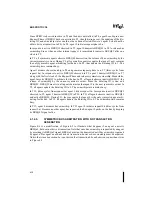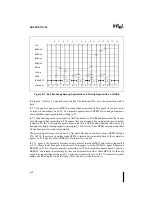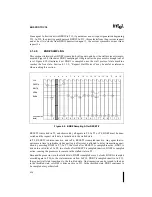
4-18
BUS PROTOCOL
4.1.6.2.
BUS REQUEST ASSERTION
The priority agent can activate BPRI# to seek bus ownership provided the reset conditions de-
scribed in Section 4.1.6.1., “Reset Conditions” are satisfied. BPRI# can be deactivated at any
time.
On observing active BPRI#, all symmetric agents guarantee no new non-locked requests are
generated.
4.1.6.3.
BUS EXCHANGE FROM AN UNLOCKED BUS
If LOCK# is observed inactive in two clocks after BPRI# is driven asserted, the priority agent
has permission to drive ADS# four clocks after BPRI# assertion. The priority agent can further
reduce its arbitration latency by observing the bus protocol and determining that no other agent
could drive a request. For example, Arbitration latency can be reduced by to two clocks by ob-
serving ADS# active and LOCK# inactive on the same clock BPRI# is driven asserted or it can
be reduced to three clocks by observing ADS# active and LOCK# inactive in the clock after
BPRI# is driven asserted.
4.1.6.4.
BUS RELEASE
The priority agent can deassert BPRI# and release bus ownership in the same cycle that it gen-
erates its last request. It can keep BPRI# active even after the last request generation provided it
can guarantee forward progress of the symmetric agents. When deasserted, BPRI# must stay in-
active for a minimum of two clocks.
4.1.7.
Bus Lock Protocol Rules
4.1.7.1.
BUS OWNERSHIP EXCHANGE FROM A LOCKED BUS
The current symmetric owner n can retain ownership of the bus by keeping the LOCK# signal
active (even if BPRI# is asserted). This mechanism is used during bus lock operations. After the
lock operation is complete, the symmetric owner deasserts LOCK# and guarantees no new re-
quest generation until BPRI# is observed inactive.
On asserting BPRI#, the priority agent observes LOCK# for the next two clocks to monitor
request bus activity. If the current symmetric owner is performing locked requests (LOCK#
active), the priority agent must wait until LOCK# is observed inactive.
4.2.
REQUEST PHASE
After completion of the Arbitration Phase, an agent is allowed to enter the Request Phase. This
phase is used to initiate new transactions on the bus, and lasts for two consecutive clocks. During
the first clock, the information required to snoop a transaction and start a memory access be-
comes available. During the next clock, complete information required for the entire transaction
becomes available.
Summary of Contents for Pentium Pro Family
Page 17: ...1 Component Introduction ...
Page 26: ...2 Pentium Pro Processor Architecture Overview ...
Page 27: ......
Page 36: ...3 Bus Overview ...
Page 62: ...4 Bus Protocol ...
Page 105: ...5 Bus Transactions and Operations ...
Page 126: ...6 Range Registers ...
Page 131: ...7 Cache Protocol ...
Page 135: ...8 Data Integrity ...
Page 148: ...9 Configuration ...
Page 161: ...10 Pentium Pro Processor Test Access Port TAP ...
Page 172: ...11 Electrical Specifications ...
Page 201: ...12 GTL Interface Specification ...
Page 229: ...13 3 3V Tolerant Signal Quality Specifications ...
Page 233: ...14 Thermal Specifications ...
Page 239: ...15 Mechanical Specifications ...
Page 241: ...15 2 MECHANICAL SPECIFICATIONS s Figure 15 1 Package Dimensions Bottom View ...
Page 252: ...16 Tools ...
Page 260: ...16 8 TOOLS Figure 16 4 Generic MP System Layout for Debug Port Connection ...
Page 264: ...17 OverDrive Processor Socket Specification ...
Page 290: ...A Signals Reference ...
Page 320: ...Index ...
Page 328: ......

